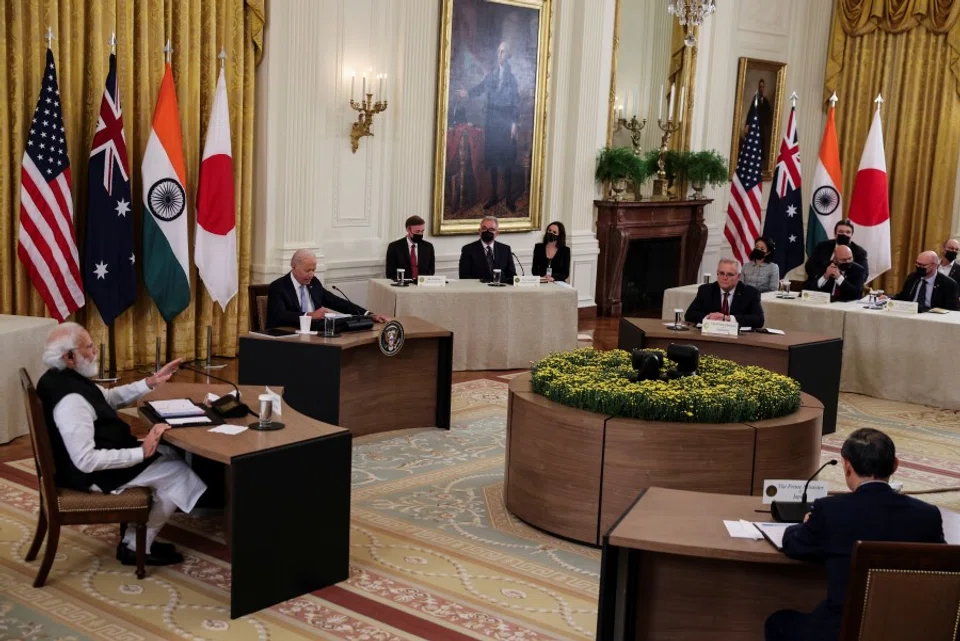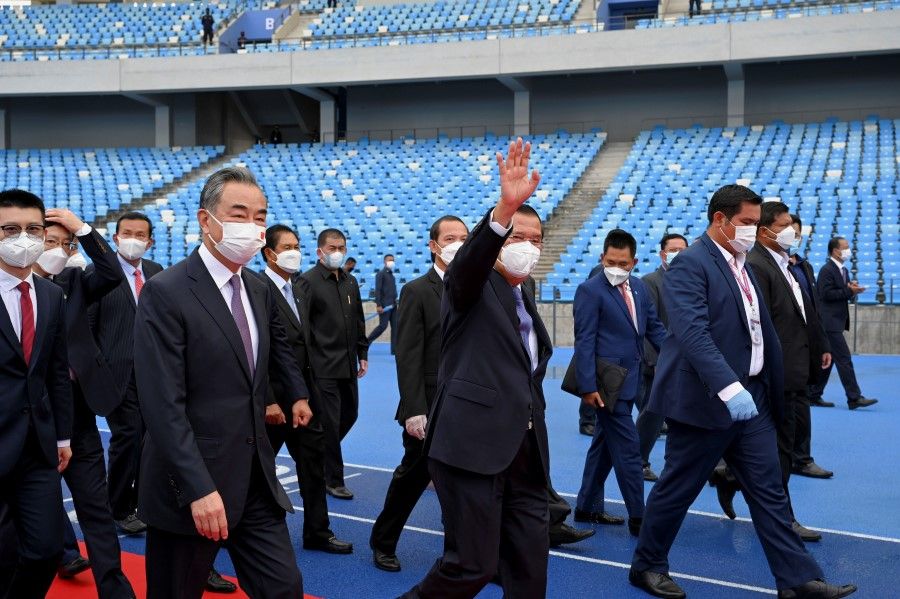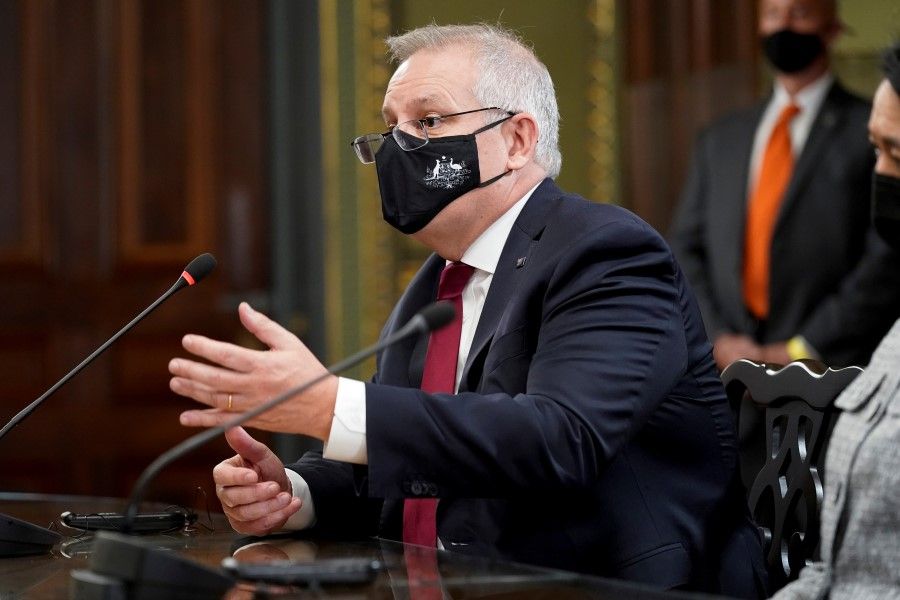Be present but don't fight with China: Can the Quad fulfill this tall order from ASEAN?

Since its inception in the wake of the Indian Ocean earthquake and tsunami in 2004, the Quad has seen major ups and downs. Initially, Quad 1.0 sought to harness intrinsic similarities in its member democracies - Australia, Japan, India and the US - but Australia soon withdrew from the grouping for fear that its Quad membership would affect its relationship with China.
A decade later, however, the Quad, and the so-called Indo-Pacific strategy underpinning it, have regained momentum in response to growing Chinese assertiveness. It places emphasis on the principles of a free, open and inclusive order, restraint from the use of coercion, freedom of navigation and fostering of shared prosperity in the region.
A virtual Quad leaders' summit was held in March 2021, emphasising a list of deliverables that would be more amenable to ASEAN member states - vaccine delivery, climate change, and critical and emerging technologies. On 24 September 2021, US President Joseph Biden met his Quad counterparts in person in Washington, indicating the grouping's growing prominence in US foreign policy. The White House said the Quad leaders will continue to focus on the areas of practical cooperation highlighted at the March summit.
There is growing regional cognisance of the threat posed by China, in particular in the maritime domain. This provides pockets of quiet support for the Quad in Southeast Asia. Still, the Quad faces difficulty in gaining widespread traction, and China remains vocal about its opposition to any arrangement perceived to curb its emergence. ASEAN also fears that its centrality will be undermined by a minilateral arrangement helmed by four extra-regional powers.

Framing the China challenge to the rules-based order
Within the Quad, there are different conceptualisations of the Indo-Pacific in four main areas, namely the geographic scope of the "Indo-Pacific", maritime security, connectivity and approach to China. Japan and the US are more forthright in countering China. Australia, until very recently, had sought to balance its economic symbiosis with China against concerns about Beijing's challenge to the rules-based order. India has stressed the inclusivity of the Indo-Pacific concept, avoiding any allusion that it is targeted at China.
Starting from 2020, however, Australia and India have taken a harder turn towards Beijing. Sino-Australian ties are severely strained by China's treatment of Uighur Muslims in Xinjiang, the rollback of democracy in Hong Kong, Chinese coercion in the South China Sea (SCS), tit-for-tat allegations of espionage and foreign meddling, and China's trade punishment against key Australian exports.
On 15 September, Australia, the UK and the US announced the historic AUKUS deal, whereby London and Washington will work together to give Australia nuclear technology to power a new class of submarines. The pact is critical to Washington and Canberra's attempts to manage China's growing military footprint in the region.
India has also turned to more outspoken advocacy of the grouping, primarily due to Sino-Indian border clashes on the Doklam plateau in 2017 and in Ladakh in 2020.
Despite the growing convergence in views about the China challenge among the Quad countries, there remains a certain reticence in using the Quad as an overt instrument to counter China. This could possibly be due to concerns about China's over-reaction. It could also reflect the Quad's recognition that regional countries do not want to be forced to take sides between the US (and its Quad partners) and China.
Speaking at the Shangri-La Dialogue in 2019, then US Defence Secretary James Mattis called for a "free and open Indo-Pacific" but he did not use the term "Quad". Similarly, the joint statement of the March 2021 Quad leaders' summit stressed the need for a "free, open rules based order", but there was no explicit mention of "China" in the statement.
Speaking at the July 2021 Fullerton Lecture in Singapore, US Defence Secretary Lloyd Austin singled out Chinese actions that Washington and its Quad partners deemed destabilising, but he did not mention the Quad as a direct counter to the perceived China challenge. By attenuating the connection between the Quad and China, Austin sought to avoid over the top rhetoric that could play into Chinese attempts to cast the group as an anti-China clique.
During the AUKUS announcement on 15 September 2021, the White House emphasised that the partnership is "not aimed (at) or about any one country" but was about upholding the "rules-based order".
...it can be argued that the four Quad members use "rules-based order" and "Indo-Pacific strategy" as omnibus terms for high principles such as human rights and dignity, the rule of law, freedom of the seas, the importance of international commitments and the peaceful settlement of disputes.
The narrative about upholding a "rules-based order" started as early as 2013, when China's terra-forming in the SCS started in earnest, and has since become the rallying cry for the revitalisation of the Quad. The use of the terms "rules-based order" and "Indo-Pacific" spiked from 2016 onwards.
Arguably, there remains definitional wooliness about what it stands for. Retired Singaporean diplomat Bilahari Kausikan argues that "rules-based order" is a "Rashomon term", the meaning of which depends on the perspective of the user. At the bottom, it can be argued that the four Quad members use "rules-based order" and "Indo-Pacific strategy" as omnibus terms for high principles such as human rights and dignity, the rule of law, freedom of the seas, the importance of international commitments and the peaceful settlement of disputes.
Among the four Quad nations, reference to these principles has turned out to be a nuanced and sophisticated way of voicing support for shared aspirations, without specifying the country of concern seen to be infringing such principles (i.e. China).

Shinzo Abe, Japan's former prime minister, did this adroitly. Speaking at the 2014 Shangri-La Dialogue, Abe stressed the importance of three "rule of law" principles to prevail in the SCS territorial disputes: clarification of claims based on international law; avoidance of the use or threat of force in pursuing claims; and peaceful settlement of disputes.
Washington has adopted this approach. At the Fullerton Lecture, Lloyd Austin stressed that regional countries in the Indo-Pacific shared certain "common principles" such as the rule of law, adherence to global commitments and the peaceful settlement of disputes. He added that the region had witnessed certain Chinese actions that "did not line up with ... shared principles". This included Beijing's actions in the SCS, "aggression" against India, coercion against Taiwan as well as "crimes against humanity" against Uighur Muslims in Xinjiang.
How the Quad can gain currency
Despite its forward momentum, the Quad is a tough sell to China and ASEAN. China is wary of any power configurations arrayed around its periphery (in particular, America's formal alliances such as the one with Japan).
In March 2018, Chinese Foreign Minister Wang Yi dismissed the Quad as an arrangement that would dissipate like "sea foam". Quite to the contrary, the Quad has gained prominence in recent years - what started as an officials-level meeting in 2017 will become an in-person leaders' meeting in September 2021.
The Quad's forward momentum has led to a rethink in China. Chinese strategists now suggest that Beijing drive wedges between the Quad members. One way of doing so is to highlight the potency of multilateral arrangements that involve China but not the US. These include the Regional Comprehensive Economic Partnership (RCEP) and the Comprehensive and Progressive Trans Pacific Partnership (or the CPTPP, the precursor from which the US withdrew in 2017; and to which China has recently expressed a desire to join).
In Southeast Asia, there is no clear, consistent and coherent picture of the Quad - some appear to be sceptical of the grouping, while others partially welcome it.
In the 2021 State of Southeast Asia Survey, less than half the respondents deemed the Quad to have a "positive" or '"very positive" contribution to regional security. In another survey conducted by the Australian Strategic Policy Institute, nearly 40% thought that Quad had more of a "diplomatic and symbolic value" rather than being a "critical initiative" for the region.
Part of this general ambivalence can be attributed to ASEAN's concerns that the Quad would undermine ASEAN-led multilateral institutions. The 2019 ASEAN Outlook on the Indo-Pacific could be seen as the grouping seeking to stamp its own imprimatur on evolving concepts of the Indo-Pacific - in particular, casting the region in a geographical frame focused on tangibles such as maritime security and connectivity, as opposed to casting it in a geopolitical frame to counter China.
What the Quad has been doing correctly - and should continue to do - is to work with and for ASEAN, and not to use the grouping as an instrument to counter China.
Cognisant of ASEAN's reservations, the US and other Quad members have sought to soft sell the Quad concept to ASEAN. After all, buy-in by ASEAN, which represents a dynamic region with enormous economic potential, will be critical if the Quad's Indo-Pacific strategy is to gain additional traction.
All the Quad members have sought to emphasise their support for ASEAN centrality in the Indo-Pacific region. At the 2021 Fullerton Lecture, Austin went to lengths to address concerns about the Quad undermining ASEAN centrality. He reiterated ASEAN's central role and went on to "applaud ASEAN for its efforts to end the tragic violence in Myanmar" (despite ASEAN having been roundly criticised by others for its ineffective response to the political crisis in the country).
What the Quad has been doing correctly - and should continue to do - is to work with and for ASEAN, and not to use the grouping as an instrument to counter China. The joint statement of the March 2021 Quad summit not only reaffirmed support for ASEAN centrality but also sought to address the region's needs, as seen in its plan to convene three working groups on vaccine delivery, climate change, and critical and emerging technologies.
In July, Kurt Campbell, the Biden administration's Indo-Pacific coordinator, said he expected the Quad to make decisive announcements on vaccine diplomacy and regional infrastructure when the grouping's leaders meet in Washington later in 2021. In the Fullerton Lecture, Austin went beyond framing US-Southeast Asia relations in the defence-security domain; instead, he offered US deliverables to the region, such as 40 million Covid-19 vaccines throughout the Asia-Pacific, including for Indonesia, Laos, the Philippines, Malaysia, Thailand and Vietnam.

By not over-emphasising geopolitics, the Quad members can help the grouping gain more traction in the region. To do so, they should avoid overt connections between the Quad and the challenges posed by China, and offer deliverables that are amicable to Southeast Asian countries.
In August 2021, Edgard Kagan gave assurance that the Quad did not expect regional countries to "act against their own interests", but is looking for partnerships in areas such as climate change, cyber security and handling the Covid-19 pandemic. The senior director at the US National Security Council further added that the Quad "does not have a letterhead" or formal institutional mechanisms, but is driven by the search for pragmatic solutions. These messages are certain to be welcomed by Southeast Asian states.
With its withdrawal from the Trans-Pacific Partnership in 2017, the US now sits outside two major regional trade deals: the RCEP and CPTPP.
Deepening their economic engagement with Southeast Asia must be a central part of the Quad members' Indo-Pacific strategy. While the US remains the single largest investor in ASEAN, with nearly US$330 billion in investment stock, it has become less important as a source of final demand for the region's exports. With its withdrawal from the Trans-Pacific Partnership in 2017, the US now sits outside two major regional trade deals: the RCEP and CPTPP.
Cognizant of negative political sentiment at home towards mega trade deals, the Biden administration has expressed caution about joining the CPTPP. Instead, it has said that it is exploring a digital trade and services agreement in the Indo-Pacific. While this is an emerging area of regional standard setting, such a pact has a narrow focus and is unlikely to satisfy regional countries desiring greater economic engagement from Washington.
In terms of infrastructure development, the Biden administration led the Group of Seven (G7) to launch the Build Back Better World (B3W) initiative in June 2021. Built on the Trump-era Blue Dot Network which involved the US, Japan and Australia, President Biden said that B3W would channel private sector capital into global projects. Compared to China's Belt and Road Initiative, B3W would serve as a "more equitable way to provide for the needs around the world". It would focus on key areas such as climate, health, digital technology and gender equity. More importantly, it would represent the values of democracies and not the "autocratic lack of values", Biden added.
Details about B3W, however, remain vague for now. The nagging problem is that Western governments have difficulty persuading private capital to flow into emerging-market infrastructure deals that will entail problems such as project delays, political interference, corruption and mismanagement, and uncertain financial returns.
Another area in which the Quad will gain further traction is the provision of maritime security, particularly in the SCS. While there are ongoing negotiations between China and ASEAN for a Code of Conduct (COC) in the SCS, ASEAN has found no solution to Chinese assertiveness in the contested maritime area. This is where the Quad, or the Quad working in tandem with like-minded partners, may prove itself useful.
Assertions of freedom of navigation have a "use it or lose it" quality - parties have to continually exercise such rights lest they be lost. In November 2020, Australia - after an absence of 13 years - was re-admitted to the Malabar exercises with the Indian, Japanese and American navies. The 2021 Malabar exercises involved Australia again, with the four Quad navies operating together in the Philippines Sea to hone their skills in areas such as combined maritime operations, anti-submarine warfare operations and live gunnery sessions.
Going forward, the Quad should continue to pursue minilateral cooperation with Southeast Asian states at the forefront of maritime disputes with China, such as The Philippines and Vietnam.

It is worth noting that the Quad is seeking to expand its reach by exercising with like-minded navies. In April 2021, France joined the navies of the four Quad countries in the La Perouse maritime exercise in the Bay of Bengal. When Exercise Malabar 2021 was ongoing in late August, the British aircraft carrier HMS Queen Elizabeth held its first drill with the Japanese Self-Defense Forces off the coast of Okinawa. Similarly, the Indian Navy carried out a naval drill with the Philippines Navy in the disputed SCS just before Exercise Malabar.
Going forward, the Quad should continue to pursue minilateral cooperation with Southeast Asian states at the forefront of maritime disputes with China, such as The Philippines and Vietnam.
A tall order
The Quad was born with a built-in dilemma: the harder it pushes for its implementation in the region, the more it generates fear among Southeast Asian states and perceptions of threat from China; the less it pushes, the more it emboldens China to challenge what is essentially a US-led rules-based order in the region.
Still, the Quad can afford to continue the route it has taken, that is, offering tangible deliverables to the region in the form of vaccine delivery, infrastructure assistance, emerging technologies, and maritime security. This will help in getting greater buy-in from ASEAN member states.
In the meantime, the Quad can well depend on China's assertiveness and even belligerence to foster what is essentially a growing wariness about Beijing. As Bilahari Kausikan has said, the Quad reflects a "growing concern" among a diverse array of countries over Chinese behaviour, and Beijing has done more than the US itself to put together a "nascent anti-China coalition".
All four Quad members already enjoy good ties with Southeast Asian countries and have "deep footprints" in the region. Each of them should continue working on these linkages without pushing the "Quad" label excessively.
Japan, for example, is the most trusted external power among Southeast Asians, the fourth largest trading partner and the second biggest source of foreign direct investment for the region. Japan has also increased its security ties with major Southeast Asian states. In September 2021, it inked an agreement with Vietnam that would enable exports of Japanese-made defence equipment and technology to Hanoi - a move seen to counter China's growing assertiveness.
The same applies to the US, which in its March 2021 Interim National Security Guidance mentioned that Singapore, Vietnam and other ASEAN member states would help Washington implement its broader Indo-Pacific strategy. During her August 2021 visit to Vietnam, Vice President Harris called on Hanoi to upgrade their comprehensive partnership to a strategic partnership. Without mentioning the Quad, she urged Hanoi to challenge Chinese coercion in the SCS.
Going forward, one of the biggest challenges for the US is the need to articulate clear goals for its relationship with China and its desired strategic position in the Indo-Pacific. By extension, the same challenges apply to the Quad.
While the US and other Quad members have been able to emphasise tangible deliverables to ASEAN and the wider Indo-Pacific, these efforts are not divorced from the larger, and implicit, goal of challenging the threat posed by China. This is a reality that will continue to cause anxiety in the region. Washington and the Quad would need to provide reassurance that the re-assertion of US power and influence and the progress of the Quad will not escalate into confrontation and conflict with China. That, however, is a tall order.
This article was first published by ISEAS - Yusof Ishak Institute as ISEAS Perspective 2021/125 "The Quad and the Indo-Pacific: Going Slow to Go Further" by William Choong.
Related: Quad now centrepiece in India's China strategy | Indian academic: The Quad gains momentum and China feels threatened | Indian academic: The Quad and ASEAN can find solutions together | Containing China: Will the Quad become an Asian mini-NATO? | Quad: A regional military alliance to contain China will not work | Quad: Containing China should not be the raison d'être for any grouping
